Travels and Stories
by Michael Frye | Jul 6, 2025 | Travels and Stories
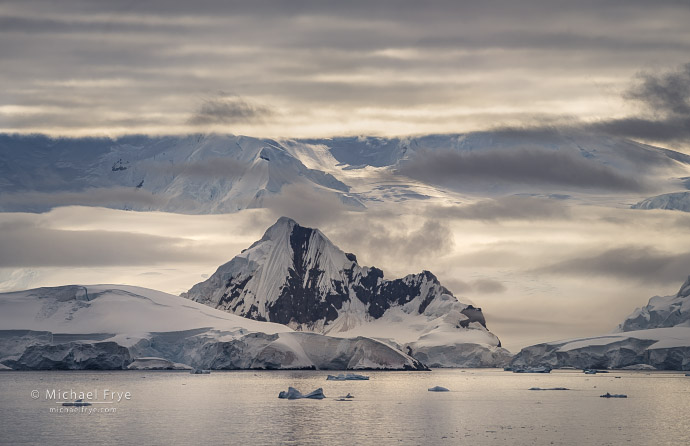
Mountains and glaciers, Antarctica
As we dive into the heat of summer, my thoughts sometimes return to the icy world of Antarctica.
People think of Antarctica as a super-cold place. But we were there in late January, which is the middle of summer down there. Most of the sea ice had melted, so there was plenty of open water, which moderated the air, and kept temperatures right around the freezing point. Not exactly balmy, but quite tolerable. I’ll take that over the summer heat here in Mariposa, where temperatures sometimes reach over 100 degrees Fahrenheit.
Of course the ice-free seas and mild temperatures don’t last long in Antarctica. In March, as the days get shorter, and temperatures drop, the sea ice starts to re-form. At Vernadsky, a Ukrainian research station on the Antarctic Peninsula that we visited during our January trip, scientists who spend the winter there have to be completely self-sufficient for six months. Ships can’t reach them because of the pack ice, and there’s no airstrip.
(more…)
by Michael Frye | May 26, 2025 | Travels and Stories, Vision and Creativity
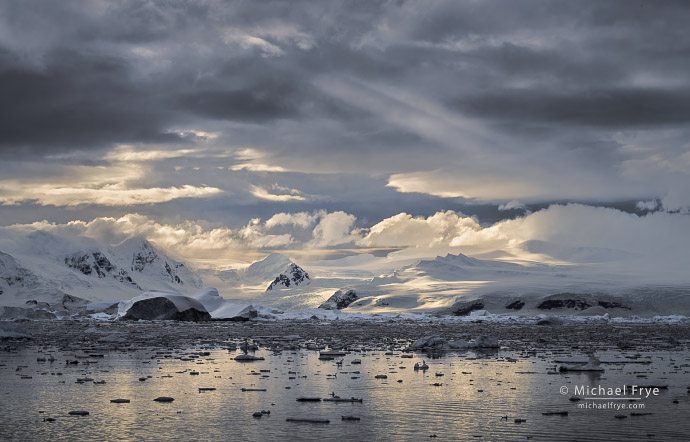
Clouds, sunbeams, and mountains, Antarctica. One of the things that surprised me about Antarctica was how bright it was. I expected some dramatic, even gloomy weather – and we got a little of that. But the days were long; it never got completely dark. And all that ice, snow, and water reflected lots of light, making everything luminous. So some of my favorite landscape images of Antarctica capture a bit of the drama of that incredible place, but also show some of the luminosity.
There’s value in photographing familiar places. Whether it’s somewhere near home, or a spot you visit repeatedly, the better you know an area, the better you’ll be able to know where to go under different conditions. And maybe more importantly, you can forge a deeper connection with that place, and that tends to manifest itself in your photographs.
On the other hand, it’s exciting to travel to new, unfamiliar destinations. We only have so much time on this earth, and most of us would like to see as much of this planet as we can while we’re here – if we have the opportunity to do so.
(more…)
by Michael Frye | May 9, 2025 | Travels and Stories, Vision and Creativity
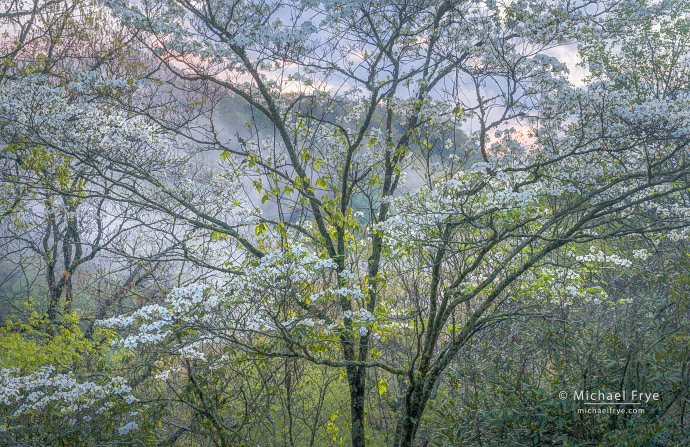
Dogwood and mist at sunset, Blue Ridge Parkway, North Carolina. This isn’t a photograph I expected to make. I almost always keep the sky out of forest compositions, and if I see an interesting sunset developing I’ll usually look for a more expansive view. But here I thought the pastel colors in the sky might complement the softness of the dogwood blossoms and lingering mist, and decided to stick with what was in front of me and see what I could do. It turned out to be one of my favorite images from the trip.
Before visiting the Smokies I’d seen many wonderful photographs of the southern Appalachian Mountains by people like Charles Cramer, Christopher Burkett, William Neill, and Nye Simmons. Their images mostly focused on the forests in spring and fall – understandably, since those eastern hardwood forests are so beautiful in those seasons. So I had certain expectations about what I might see, and the kind of photographs I might make, based on seeing their work.
I certainly hoped and expected to photograph dogwoods blooming. But spring came early to the lower elevations, and the dogwoods were mostly done by the time Claudia and I arrived a week before the conference. We did find a few dogwoods still blooming at higher elevations, so I made it a point to photograph those before they faded. But I realized that I wouldn’t be doing much dogwood photography on this trip, so I had to let go of that expectation and focus on other things.
(more…)
by Michael Frye | May 4, 2025 | Composition, Light and Weather, Travels and Stories
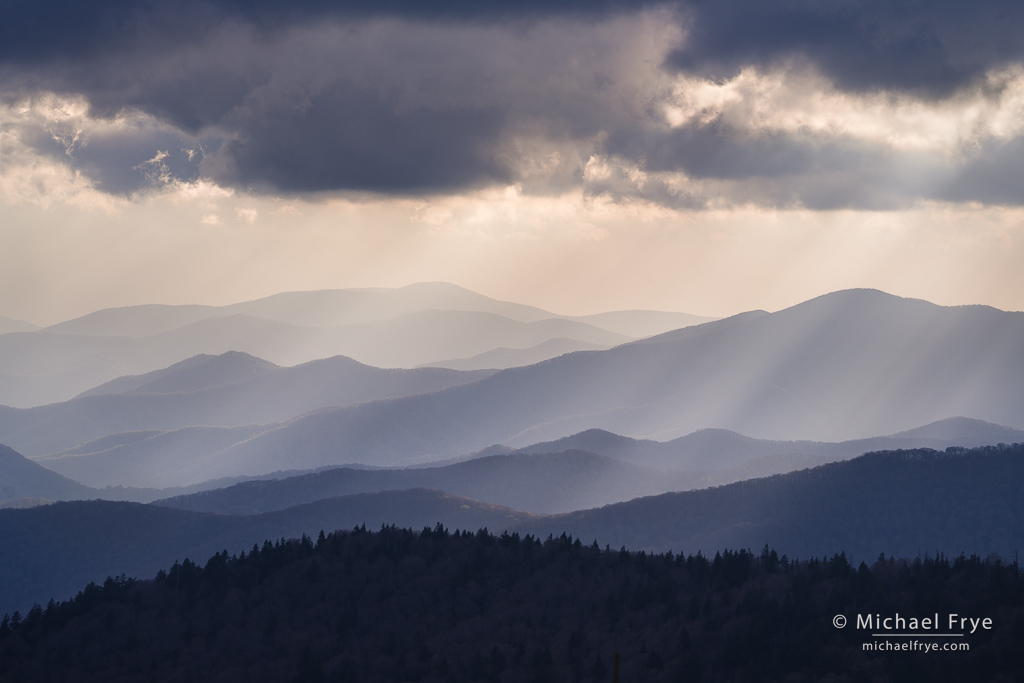
Sunbeams and ridges, Great Smoky Mountains NP, North Carolina
Claudia and I just returned from Tennessee and the Out of the Great Smoky Mountains photo conference. Technically this wasn’t our first visit to Great Smoky Mountains National Park, since eleven years ago we landed briefly in Cherokee, on the North Carolina side of the park, after driving to the southwest terminus of the Blue Ridge Parkway. But for all practical purposes this was our first time exploring the park, and definitely the first time visiting the Tennessee side.
And we loved it. Well, most of it. Gatlinburg is… something. And the traffic in Cades Cove can be crazy. But the park itself is beautiful. I love the hardwood forests of the Smokies, which are so similar to the woods I played in as a child growing up in the Northeast. These forests were especially pretty decked out in their bright spring greens, with rushing creeks and rivers cascading under the arcing branches of the trees.
(more…)
by Michael Frye | Mar 18, 2025 | Travels and Stories, Wildlife Photography
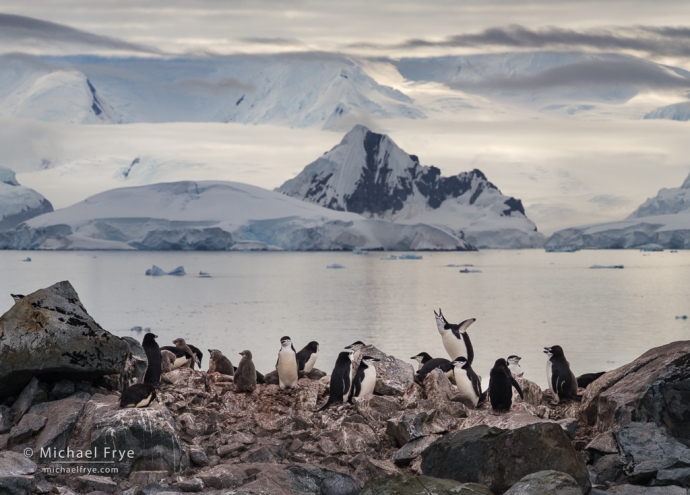
Mountains, glaciers, and chinstrap penguins, Antarctica
At the end of our trip to Antarctica for Visionary Wild, I told Claudia that the thing I was going to miss most was seeing penguins every day. It seemed strange to be heading back to a world without penguins, since they had been a daily part of our lives for two weeks.
And penguins are so much fun to watch. While supremely graceful in water, they’re awkward on land. Yet every day many penguins climb and descend from their nests on slopes so steep they would intimidate most humans. They fall all the time, but always seem to bounce back up and keep going. They’re determined and dedicated parents; they have to be to thrive and reproduce in this harsh environment. And they’re feisty. They won’t tolerate other penguins getting too close to their nest, or intruding on their space.
(more…)
by Michael Frye | Feb 26, 2025 | Travels and Stories
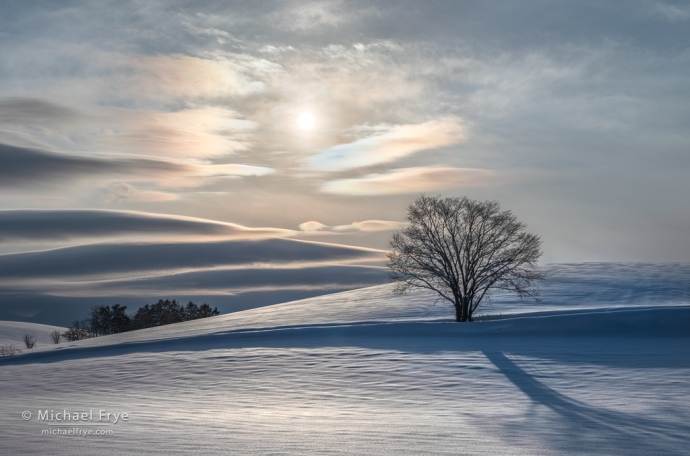
Sun, tree, snow, and cloud iridescence, Hokkaido, Japan. We were actually headed back to the hotel for breakfast when the sun broke through clouds, creating some beautiful light. My co-leader on this trip, Toshiki Nakanishi, knew just the spot to head for, with this lone tree on a snowy hillside. I bracketed five frames, two stops apart, to get detail in the bright clouds as well as the foreground shadows. The blue and gold colors near the sun are cloud iridescence in ice clouds.
After returning from Antarctica, Claudia and I spent a week at home, then flew across the Pacific to lead another trip for Visionary Wild on Hokkaido, Japan’s northernmost island.
Hokkaido is known for its abundant snow in winter, and has become a popular destination for skiers and snowboarders. We saw many, many skis and snowboards on the luggage carousel at the Sapporo airport.
Hokkaido has also become known in the photography world for its minimalist winter landscapes, with trees, fences, and other objects isolated against the white, snowy backdrop. Shinzo Maeda produced some beautifully-simple color work in Hokkaido in the 80s and 90s, and then Michael Kenna brought his singular style of black-and-white photography to the island in the early 2000s (and continues to photograph Hokkaido today).
(more…)














